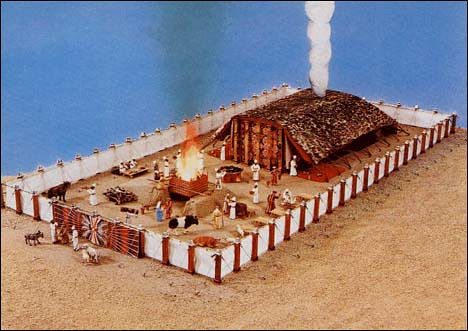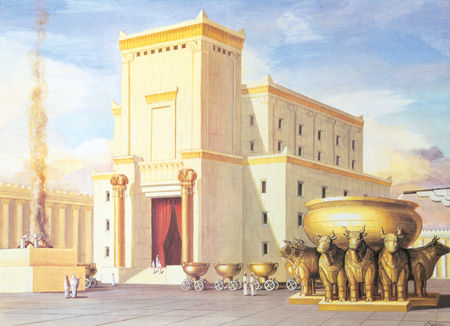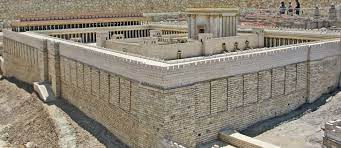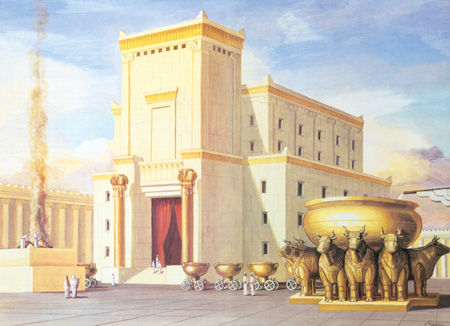THE ANALOGY OF THE TABERNACLE (Part 1)
- Taneallea Feddis

- Aug 7, 2021
- 12 min read
Updated: Oct 29, 2021

“And let them make Me a sanctuary, that I may dwell among them” (Exodus 25:8, NKJV). The temple is the dwelling place of God. It is a place for communion, worship, and sacrifice. However, the temple of the Most Holy One is not just any old building; it is holy, a bridge between Heaven and earth. It is the place where God dwells. It is a place of beauty, magnificence and splendour. The glory of God fills it throughout. There is no night there because the glory of God shines brightly there. The description here seems to be analogous to the description of the New Jerusalem that we find in Revelation 21. This is because the final and only permanent temple that will ever exist on the earth will be the New Jerusalem!
However, the first temple we find in the history of mankind is the Garden of Eden, or the Garden of God. It was the bridge between Heaven and earth. It was a place where God communed with man (Adam), where He taught man about the mysteries of creation; and after sin entered the world, it became the site of the very first sacrifice. Sinful man was soon evicted from God’s presence and his Holy Garden. However, mankind was not to live without hope. Ultimately, God would later create a means and a site through which He may commune with mankind again. Temples were to become more than just a bridge to God and a symbolic Eden. They were to become a vehicle for salvation.
The temples in human history, in any culture or religion, are elaborate and richly decorated buildings dedicated to a deity. While the pagan world constructed many temples still popular today, the idea to build one was not man’s idea or even the Devil’s for that matter, it was God's. Their design and purpose seem to mimic the Garden of God. The walls of several of these ancient temples were lined with gold representing the glory of the deity, and the magnificence and splendour of many inspire awe and reverence.
The original design and purpose of the temple was first brought to our attention through Eden. Its purpose was for communication between Heaven and earth, between God and man, to edify, or to teach, the ways and the nature of God and creation (Exodus 25:22), and later to explain the plan of redemption. When man no longer had access to Eden, God found an alternative, an earthy temple, which was to be richly decorated with patterns of golden flowers and trees (Exodus 25:31-32), an earthly reflection of Eden. The terrestrial temple has certain properties that are different from the original Garden Temple. It would have physical walls to restrict access to unauthorised persons; the presence of God would be veiled to protect sinful man from His glory; and it would be a place for atonement in addition to being a place for communion. Furthermore, it was to be placed in the mist of the congregation of Israel during the desert wanderings and in the mist of the settled Promised Land, in Shiloh and later in Jerusalem – the permanent home of the Tabernacle/Temple (Numbers 2:2, Psalms 78:60-69, Jeremiah 7:12, Psalms 68:29).
All the symbols of Eden are reflected in the furnishings for the earthly temple. The tree of life being represented by the laws of God and the tablets upon which the Ten Commandments were written for which the reward for obedience is eternal life (Deuteronomy 11:27-28, 28:9, Genesis 2:16-17, Revelation 14:12, 22:1-2). It is important to note that the Tree of the Knowledge of Good and Evil represents sin and disobedience to God’s commands for which the penalty is death, and the antithesis is life. The throne of God being represented by the mercy seat (Exodus 25:20, 25:22, Ezekiel 10:1, 28:14). The presence of God being the Shekinah (Exodus 25:21-22). The Word of God that teaches being the Table of Showbread (John 6:32-71).The Holy Spirit being the Menorah (the seven-branch candlestick) which also represents the angels presiding over the seven churches (Revelation 4:5) as well as representing the seven spirits of God (Isaiah 11:2). The River of Life being the Bronze Basin used by the priests to cleanse themselves and the offerings (Exodus 30:17-21). The Spirit of Holiness being the sacred fire for purification purposes (Leviticus 6:12-13). Our prayers being the sweet aroma going up to God and is represented by the incense, which burned day and night and coincided with the lighting of the Menorah (Exodus 30:1-9). The altar of sacrifice being the price of sin paid (Hebrews 7:27). Finally, the priests representing mankind, with their High Priest and King being Yeshua haMashiach (Jesus Christ). Later in the New Jerusalem, the sealed 144,000 in Revelation will act as priests and Yeshua the High Priest and King (Hebrews 7:21-28, 8:1-6; Revelation 1:6, 5:10, 20:6). After Adam sinned, God added a veil to separate the physical from the spiritual and essentially separating us from God and protecting us from His glory. The veil is a physical barrier. In Eden it was the cherubim guarding the way to the Tree of Life (Genesis 3:24).
That said, the temple of God is not simply any old building, and it is certainly not a church building, because it must be a design of God to be a replacement of Eden. However before we get too deep into the symbols reflected in God’s Holy Temple, let us first look at the past temples; those in our sphere of understanding, because they were built by mankind on earth. Notice firstly that there are two main types of temples, those built by God Himself through the Word, that is Yeshua haMashiach (Jesus, the Messiah), Eden and the New Jerusalem, and those built by God through mankind, that is by Moses and Solomon, the terrestrial temples.
The Mosaic Tabernacle
The first terrestrial temple built with the help of man was the Mosaic Tabernacle. After Israel had been called out of Egypt, God directed Moses on how to build his tabernacle while wondering in the wilderness (Exodus 25-26). He also instructed Moses on the establishment of the priesthood (Exodus 28). He left nothing up to Israel’s deliverer (Exodus 25:9). Moses was given detailed instructions on precisely how to make each element of the tabernacle, the role and attire of the priests, the rituals and sacrifices to be held in the tabernacle and how each equipment and ornament were to be used for the daily, weekly, monthly, and annual festivals and offerings (Hebrews 8:4-5). The design, the shape, the movement from one part of the temple to another was a reflection of the Eden Temple. The design was to be simple and natural.

King Solomon’s Temple
During his reign, King David felt that with the establishment of the Kingdom of Israel and the construction of the royal palace that God needed a permanent dwelling place among His people (2 Samuel 7:2). He, though faithful to God, was not chosen to build the temple. His son, Solomon was. Solomon followed the specific instructions detailed in the Torah regarding the building materials, the instruments to be used, the ornaments, and the furniture. Again we see deliberate similarities between the Tabernacle and the Eden Temple in the description and furnishings of this more permanent structure; and nothing was left up to the creativity of Solomon (1 Chronicles 28:11-13).
It is important to note that although the Bronze Basin was to represent the river of life in the Tabernacle, there was an actual stream, the Gihon, gushing occasionally directly beneath Solomon's Temple, which runs to a pool (the pool of Siloam) exactly in the centre of the Holy Land and was used in the temple services (Jewish Encyclopaedia, 1906). The Gihon was dubbed the “Spring of Yeshua” by the Hebrews meaning “the Spring of Salvation”. They created a pool, the pool of Siloam, by damming the stream. They did this because the stream did not flow constantly all the time; and this precious water was used to cultivate the Royal Garden and for use by the city in addition to the temple. People would also bathe in this water as it was believed to have healing properties (John 5:1-4[1]). This would later become ironic as Yeshua’s first miracle during His ministry was perhaps performed here at the pool of the ‘Spring of Yeshua’ (John 5:5-8).
Solomon’s temple would later be destroyed when God allowed Israel to be conquered and captured by Babylonian forces in around 586 BCE. The House of Judah (the tribes of Judah and Benjamin) was to remain in Babylon for seventy years. During their captivity, Jerusalem and the temple would be left desolate and in ruins (Ezekiel 6 & 12, 15:8), while the temple vessels, and perhaps the Ark of the Covenant, were taken to become an addition to the king’s treasury in Babylon (Jeremiah 20:4-5, Ezra 5:11-15).

The Second Temple
After the Babylonian captivity, the remnants of Israel returned home zealous for God. In all the history of the Hebrew people, it was only after this period that as a nation they truly abandoned all pagan gods and became zealots of the law of God (Jewish Encyclopaedia, 1906). Finally, no idols would be found in any home or public place in Jerusalem. The Israelites finally learned to put away their idols and became more obedient to the commands of God. Their return saw the rebuilding of the Second Temple in Jerusalem, but in 167 BCE it would be desecrated and plundered again by Antiochus IV Epiphanes (1 Maccabees 1:20-64). It would later be renovated by King Herod in the first century AD and become known for its magnificence and splendour. This was the very temple that Yeshua knew and worshipped at while He was on earth. Unfortunately, the temple was to be destroyed again by enemy forces, the Romans, in AD 70 during the Jewish revolt. By contrast, however, as magnificent as this temple was, it did not hold anything close to the splendour of the Solomon Temple; and there were other differences.
During the rebuilding of the Temple in Jerusalem (also called the Second Temple), they used the materials they had at the time and made available by King Cyrus of Persia; and although they may have had some artistic license in its appearance they did try to replicate Solomon’s Temple as best as they could. Another difference was the fact that the ark of the covenant, the Shekinah (the settling presence of God) and the Ruach Hakodesh (the Spirit of Holiness) were missing from the Holy of Holies (Jewish Encyclopaedia, 1906). Other items like the pot of manna and Aaron’s rod, the Urim and Thummim, the Holy Oil and Sacred Fire were also missing; and instead of a wall, separating the Holy Place from the Most Holy Place, there was a curtain. However, the Menorah (the golden seven-branched candlestick), the Table of Showbread and the altar of incense with its golden censers were restored to the temple.
It is important to note that while Solomon’s Temple and the Mosaic Tabernacle were related to liberty and freedom in God and the Torah, the Second Temple became related to a set of rigid and burdensome rites and corrupted customs delineated by the Babylonian Talmud (Mark 7:1-23; Mathew 23:13-34; John 8:44). The Laws of God was made to be burdensome and a penance for earlier national sins. This may be symbolic to the human condition and how we gradually stray further and further away from the Holiness of God as we progress through the ages, and how righteousness will become increasingly rare as wickedness and legalism become more prevalent.

The Living Temple
The wonder of the temples was the fact that they were truly God’s temples in the sense that He was the architect and He literally dwelled there - His presence (the Shekinah glory) could be seen by the whole host of Israel whenever He was present with them. During Yeshua’s ministry, He explained that God would no longer dwell in a building. Instead, He will dwell in the hearts of men after His death and resurrection (1 peter 2:5). At Pentecost, the disciples and all who were gathered in Jerusalem that day saw the establishment of the fourth temple - the congregation of God, His faithful people who had accepted Him as their personal Saviour and had been baptised by water and the Spirit. On this day, they received the Holy Spirit, the mind and presence of God, within their bodies, with the power to be obedient to Him and to display His power on earth. This temple is not a church building; it is a living vessel with all the characteristics of the first two earthly temples and a far more powerful means for communion and the atonement of sins. Interestingly, while the Second Temple in Jerusalem was related to legalism and rigid laws, the living temple reflects liberty in God and His Laws like the first two temples were to the Hebrews (2 Corinthians 3:17, James 1:25, 2:12 Luke 4:18, Romans 8:21).
The human temple is not fashioned by men, it is fashioned according to the design of the Father and absolutely nothing is left to our creativity (Jeremiah 1:5, Psalms 139:16). When a person decides to dedicate his or her life to God, Elohim (God in Hebrew) personally works on the mind, the body, and the environment around that person (Romans 8). The glow that eventually reflects off this proselyte is a sign to the inhabitants of this world that he/she is a living temple of God offering daily sacrifices to Him (Romans 8:16-17). When you accept and start to obey God His glory shines from you in everything you do, and in everything that happens to you in your environment. Changes are seen in behaviour, outlook, attitudes, appearance, and lifestyle. These changes are seen by the people around us and may be identified as the Father living in you through the fruits that they see you produce – love, joy, peace, long-suffering, kindness, goodness, faithfulness, gentleness, and self-control (Galatians 5:22-23). Indeed the seat of the mind is the most holy place where God dwells and He will not enter a temple where there is unforgiveness and sin shutting Him out (Romans 8: 6-10). For this reason, we should conduct ourselves by exercising discipline and self-control in all that we do or say in order to reverence the Sanctuary of God. It is important to emphasize that this is not a church building. God dwells in the hearts and minds of His children. “You also, as living stones, are being built up a spiritual house, a holy priesthood, to offer up spiritual sacrifices acceptable to God through Jesus Christ” (1 Peter 2:5, NKJV). The true church of Elohim is the sum total of all His children who love Him and keep His commandments. Therefore, one cannot go out to find God’s church. To find it we must search for Him directly (Matthew 6:33). When we receive the Holy Spirit, we are begotten[2] into His congregation (1 Corinthians 4:15, 1 Peter 1:3) which leads us to being “born again” when Yeshua returns as King of Kings.
All the attributes of the past temples of God are present in the Spirit-filled child of God See Part 2 of this teaching). He communes with us through His spirit that is active within us. He teaches us through His Spirit, which is a bridge between Heaven and earth, and it is by His Spirit that we obtain atonement that leads to perfection. God does the work of perfecting the believer through constant communion with Him. Ultimately the kingdoms of the world will belong to Him. However until that time, Yeshua said that the Kingdom of Heaven will not be tangible, and if we were to try and look for it, we will not be able to find it (Luke 17:20-21).
Most ardently, God desires to dwell with His people and so he has always created a way to do so. Ultimately, nothing on earth lasts forever, and even the era of God dwelling in living temples must one day come to an end like all the others. Fortunately, for us, however, He will provide another dwelling place that is closer to the original model, the Garden of Eden or as I like to call it Paradise, this will be known as the New Jerusalem.
The New Jerusalem Temple
“…Behold, the Tabernacle of God is with men, and He will dwell with them, and they shall be His people, and God Himself will be with them and be their God” (Revelation 21:3). The fifth temple is a future one that has only been mentioned in prophecy (Revelation 21:1-3, Mark 14:58, Psalms 48:2, Isaiah 2:2-4, 24:23, Micah 4:2-7). According to Jewish eschatology, Herod’s Temple will be replaced one day by a third more glorious and permanent temple. In Christian eschatology, this third temple will be in the New Earth and is the New Jerusalem. Although there has been a lot of debate on this topic, most theologians would agree that it is most accurately described as a second Eden (Revelation 22). Certain features present in Eden, will be seen again in the New Jerusalem: the tree of life, the river of life, the presence and glory of God, no day or night and no sin. All the characteristics of God’s temple will also be there: His presence (the Shekinah glory), the annual holy feasts will be observed (Isaiah 66:22-23), it will be a place for the edification (education) of the nations (gentiles), the atonement for sin will be finalised, the throne of God (the mercy seat) will be there, and the law of God will be enforced (Zachariah 14:16-19). It will truly be a return to Eden. “(For him) that overcometh will I make a pillar (an altar or monument) in the temple of my God, and he shall go no more out: and I will write upon him the name of my God, and the name of the city, which is the New Jerusalem, which cometh down out of heaven from my God: and I will write upon him my new name” (Revelation 3:12, KJV).
Footnotes: [1]Some translations remove verses 3b-4. Go back to where I left off. [2]Despite the most prevalent teachings on this topic, there is a difference between being “begotten” into the family of Elohim and being “born again”. We are begotten or conceived by the Holy Spirit first (here and now) in the womb of the earth (2 Esdras 5:48-49) then we are reborn (lit. born again) into the family of Elohim (a future event). See John 3:1-21. Go back to where I left off.
Sources:
1. The Holy Bible
2. Jewish Encyclopaedia, 1906




コメント